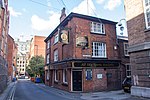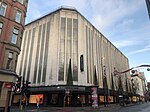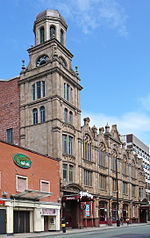Lincoln House, Manchester

Lincoln House was an office building on Deansgate in Manchester, England. It was designed in the 1980s by Holford Associates. It was completely clad in glass and was designed as a deliberate response to the 1960s and 1970s Brutalist architecture common in many British cities. It was built in 1986 for the Lincoln House Chambers, a legal practise based in Manchester.By the 1980s the Manchester City Council Planning Department rejected Brutalist proposals in the city believing such buildings to be cold and depressing pieces of architecture. The department were instead inclined to approve safe architecture such as brick buildings. Holford Associates set about fulfilling this move forward by proposing a glass building which demonstrated the latest technologies and improvements in neoprene sealants.It was demolished in 2017.
Excerpt from the Wikipedia article Lincoln House, Manchester (License: CC BY-SA 3.0, Authors, Images).Lincoln House, Manchester
Deansgate, Manchester City Centre
Geographical coordinates (GPS) Address Nearby Places Show on map
Geographical coordinates (GPS)
| Latitude | Longitude |
|---|---|
| N 53.4801 ° | E -2.2481 ° |
Address
OneTwoFive Deansgate
Deansgate 125
M3 2BY Manchester, City Centre
England, United Kingdom
Open on Google Maps











